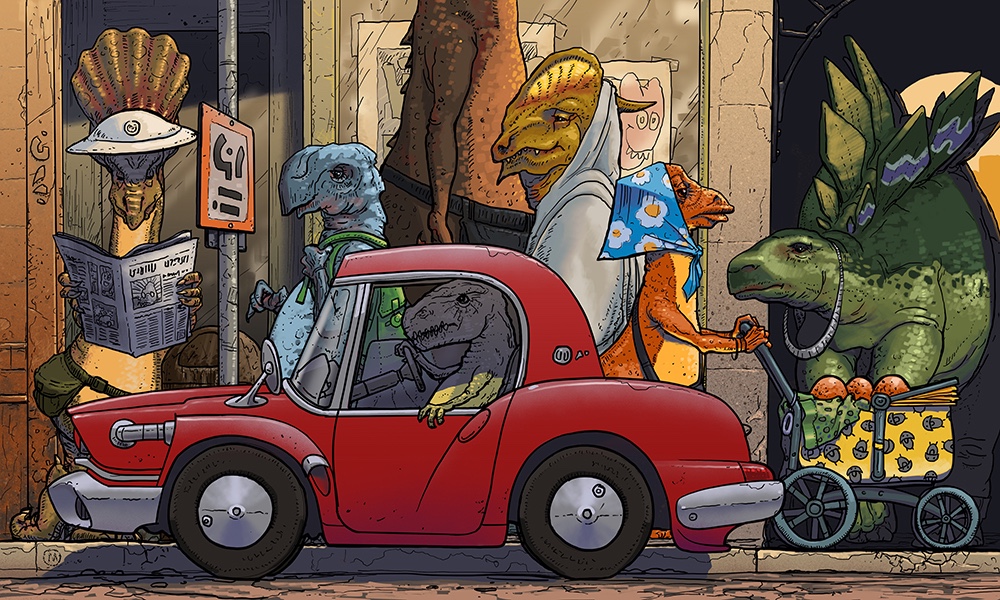How Would We Know If Intelligent Life Existed on Earth Before Humans?

Reptilian menaces called Silurians evolved on Earth before humankind — at least in the "Doctor Who" rendition of the universe. But science fiction aside, how would we know if some advanced civilization existed on our home planet millions of years before brainy humans showed up?
This is a serious question, and serious scientists are speculating about what traces these potential predecessors might have left behind. And they're calling this possibility the Silurian hypothesis.
When it comes to the hunt for advanced extraterrestrial civilizations that might exist across the cosmos, one must reckon with the knowledge that the universe is about 13.8 billion years old. In contrast, complex life has existed on Earth's surface for only about 400 million years, and humans have only developed industrial civilizations in the last 300 years. This raises the possibility that industrial civilizations might have been around long before human ones ever existed — not just around other stars, but even on Earth itself. [Greetings, Earthlings! 8 Ways Aliens Could Contact Us]
"Now, I don't believe an industrial civilization existed on Earth before our own — I don't think there was a dinosaur civilization or a giant tree sloth civilization," said study co-author Adam Frank, an astrophysicist at the University of Rochester in New York. "But the question of what one would look like if it did [exist] is important. How do you know there hasn't been one? The whole point of science is to ask a question and see where it leads. That's the essence of what makes science so exciting."
Artifacts of human or other industrial civilizations are unlikely to be found on a planet's surface after about 4 million years, said Frank and study co-author Gavin Schmidt, director of NASA's Goddard Institute for Space Studies in New York. For instance, they noted that urban areas currently take up less than 1 percent of Earth's surface, and that complex items, even from early human technology, are very rarely found. A machine as complex as the Antikythera mechanism — which is considered to be the world's first computer from ancient Greece — remained unknown until the development of elaborate clocks in RenaissanceEurope.
One may also find it difficult to unearth fossils of any beings who might have lived in industrial civilizations, the scientists added. The fraction of life that gets fossilized is always extremely small: Of all the many dinosaurs that ever lived, for example, only a few thousand nearly complete fossil specimens of the "terrible lizards" have been discovered. Given that the oldest known fossils of Homo sapiens are only about 300,000 years old, there is no certainty that our species might even appear in the fossil record in the long run, they added. [In Images: The Oldest Fossils on Earth]
Instead, the researchers suggested looking for more subtle evidence of industrial civilizations in the geological records of Earth or other planets. The scientists focused on looking at the signs of civilization that humans might create during the Anthropocene, the geological age characterized by humans' influence on the planet.
Sign up for the Live Science daily newsletter now
Get the world’s most fascinating discoveries delivered straight to your inbox.
"After a few million years, any physical reminder of your civilization may be gone, so you have to look for sedimentary anomalies, things like different chemical balances that just look wacky," Frank said.
One sign of industrial civilization may have to do with isotopes of elements such as carbon. (Isotopes of an element vary in how many neutrons they possess in their atomic nuclei — for example, carbon-12 has six neutrons, while carbon-13 has seven.)
For instance, humans living in industrial civilizations have burned an extraordinary amount of fossil fuels, releasing more than 500 billion tons of carbon from coal, oil and natural gas into the atmosphere. Fossil fuels ultimately derive from plant life, which preferentially absorb more of the lighter isotope carbon-12 than the heavier isotope carbon-13. When fossil fuels get burned, they alter the ratio of carbon-12 to carbon-13 normally found in the atmosphere, ocean and soils — an effect that could later be detected in sediments as hints of an industrial civilization.
In addition, human industrial civilizations have also discovered ways to artificially "fix nitrogen" — that is, to break the powerful chemical bonds that hold nitrogen atoms together in pairs in the atmosphere, using the resulting single nitrogen atoms to create biologically useful molecules. The large-scale application of nitrogenous fertilizers generated via nitrogen fixing is already detectable in sediments remote from civilization, the scientists noted.
The Anthropocene is also triggering a mass extinction of a wide variety of species that's likely visible in the fossil record. Human industrial activity may also prove to be visible in the geological record in the form of long-lived synthetic molecules from plastics and other products, or radioactive fallout from nuclear weapons.
One wild idea the Silurian hypothesis raises is that the end of one civilization could sow the seeds for another. Industrial civilizations may trigger dead zones in oceans, causing organic material (from the corpses of organisms in the zones) to get buried that could, down the line, become fossil fuels that could support a new industrial civilization. "You could end up seeing these cycles in the geological record," Frank said.
All in all, thinking about the impact that a previous civilization has on Earth "could help us think about what effects one might see on other planets, or about what is happening now on Earth," Frank said.
Schmidt and Frank detailed their findings online April 10 in a study to be published in a forthcoming issue of the journal International Journal of Astrobiology.
Original article on Live Science.











